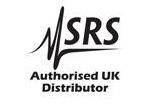SRS SR570 Low Noise Current Preamplifier
- 5 fA/√Hz input noise
- 1 MHz maximum bandwidth
- 1 pA/V maximum gain
- Adjustable bias voltage
- Two configurable signal filters
- Variable input offset current
- Line or battery operation
- RS-232 interface
Lambda Exclusive Promotion:
Additional 12 months warranty for free (2 years total) via our UK Service Centre.
The Stanford Research Systems SR570 is a low-noise current preamplifier capable of current gains as large as 1 pA/V. High gain and bandwidth, low noise, and many convenient features make the SRS SR570 ideal for a variety of photonic, low temperature and other measurements.
Gain
The SR570 has sensitivity settings from 1 pA/V to 1 mA/V that can be selected in a 1-2-5 sequence. A vernier gain adjustment is also provided that lets you select any sensitivity in between.
Gain can be allocated to various stages of the amplifier to optimize the instruments performance. The low noise mode places gain in the front end of the amplifier for the best noise performance. The high bandwidth mode allocates gain to the later stages of the amplifier to improve the frequency response of the front end. In the low drift mode, the input amplifier is replaced with a very low input-current op amp, reducing the instrument’s DC drift by up to a factor 1000.
Filters
The SR570 contains two first-order RC filters whose cutoff frequency and type can be configured from the front panel. Together, the filters can be configured as a 6 or 12 dB/oct rolloff low-pass or high-pass filter, or as a 6 dB/oct rolloff band-pass filter. Cutoff frequencies are adjustable from 0.03 Hz to 1 MHz in a 1-3-10 sequence. A filter reset button is included to shorten the overload recovery time of the instrument when long filter time constants are used.
Input Offset and DC Bias
An input offset-current adjustment is provided to suppress any undesired DC background currents. Offset currents can be specified from ±1 pA to ±1 mA in roughly 0.1 % increments. The SR570 also has an adjustable input DC bias voltage (±5 V) that allows you to directly sink current into a virtual null (analog ground) or a selected DC bias.
Toggle and Blanking
Two rear-panel, opto-isolated TTL inputs provide additional control of the SR570. A blanking input lets you quickly turn off/on the instrument's gain which is useful in preventing front-end overloading. A toggle input inverts the sign of the gain in response to a TTL signal allowing you to perform synchronous detection with a chopped signal.
Battery Operation
Three rechargeable lead-acid batteries provide up to 15 hours of battery-powered operation. An internal battery charger automatically charges the batteries when the unit is connected to the line. The charger senses the battery state and adjusts the charging rate accordingly. Two rear-panel LEDs indicate the charge state of the batteries. When the batteries become discharged they are automatically disconnected from the amplifier circuit to avoid battery damage.
No Digital Noise
The microprocessor that runs the SR570 is "asleep" except during the brief interval it takes to change the instrument's setup. This ensures that no digital noise will contaminate low-level analog signals.
RS-232 Interface
The RS-232 interface allows listen-only communication with the SR570 at 9600 baud. All functions of the instrument (except power on) can be set via the RS-232 interface. The RS-232 interface electronics are opto-isolated from the amplifier circuitry to provide maximum noise immunity.
| Input | |
| Inputs | Virtual null or user-set bias (±5 V) |
| Input offset | ±1 pA to ±1 mA adjustable DC offset current |
| Maximum input | ±5 mA |
| Noise | See graphs |
| Sensitivity | 1 pA/V to 1 mA/V in 1-2-5 sequence (vernier adj. in 0.5 % steps) |
| Frequency response | ±0.5 dB to 1 MHz. Adjustable front-panel frequency response compensation for source capacitance. |
| Grounding | Amplifier ground is fully floating. Amplifier and chassis ground are available at rear panel. Input ground can float up to ±40 V. |
| Filters | |
| Signal filters | 2 configurable (low-pass or high-pass) 6 dB/oct rolloff filters. -3 dB points are settable in a 1-3-10 sequence from 0.03 Hz to 1 MHz. |
| Gain allocation: | |
| Low noise | Gain is allocated to the front end for best noise performance. |
| High bandwidth | Front-end gain is reduced for optimum frequency response. |
| Low drift | Low bias current amplifier is used for reduced drift at high sensitivity. |
| Filter reset | Long time constant filters may be reset with front-panel button. |
| Output | |
| Gain accuracy | ±(0.5 % of output + 10 mV) @ 25°C |
| DC drift | see table below |
| Maximum output | ±5 V into a high impedance load |
| General | |
| External blanking | TTL input sets gain to zero |
| External toggle | TTL input inverts gain polarity |
| Rear panel biasing | ±12 VDC @ 200 mA, referenced to amplifier ground |
| Computer interface | RS-232, 9600 baud, receive only |
| Power | 100/120/220/240 VAC, 6 watts charged, 30 watts while charging. Internal batteries provide 15 hours of operation between charges. Batteries are charged while connected to the line. |
| Dimensions | 8.3" × 3.5" × 13.0" (WHL) |
| Weight | 15 lbs. (batteries installed) |
| Warranty | One year parts and labor on defects in materials and workmanship |
![]() Stanford Research Systems SR570 datasheet
Stanford Research Systems SR570 datasheet
![]() Stanford Research Systems SR570 user manual
Stanford Research Systems SR570 user manual
![]() Why buying from Lambda makes sense
Why buying from Lambda makes sense













